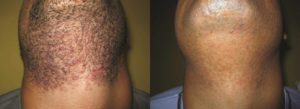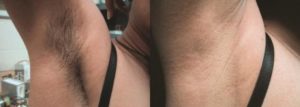Everyone can benefit from laser hair removal treatment. Saving time in the morning and feeling confident that you’re always sundress-ready is a wonderful feeling. That’s why at Reflections we’ve made it our mission to curate a vast collection of devices in order to have safe options for any complexion.
WHY WERE LASER TREATMENTS CONSIDERED UNSAFE FOR DARK SKIN TONES IN THE PAST?

Laser hair was originally done using IPL (intense pulsed light) many years ago. Some practices continue to use IPL as a hair removal method even though better options have come along. If you’re familiar with IPL treatments, you may know that they are only safe for Fitzpatrick skin types 1-4. For patients any deeper in complexion than a Fitzpatrick 4, including those with Asian, Indian, or African heritage, this device is not a safe treatment option. Unfortunately, because IPL devices are FDA-Approved for some at-home uses, these devices are often what you’ll find in home laser kits, like Kenzzi (we made video and blog on at-home laser hair removal – there is 1 device we give a green light to – check that out here).
Now with the expansion of technology into Nd:Yag 1064 lasers, patients of all skin colors are able to get hair removal not only safely, but as effectively. This is a really important note, because the first lasers that hit the market could treat skin of color, but they had to be turned down to very low settings in order to be safe – and when they weren’t, we started seeing bad complications, like burns, from laser hair removal.
Unfortunately, many practices still use these older technologies, because they are less expensive for the practice to invest in, and the manufacturers make claims that they work on skin types – which they do, just not effectively. And in other practices, nurses perform this procedure without the real scientific understanding of how lasers target the hair follicle without harming the surrounding skin – and that can be equally disastrous. This is where the myth that skin of color can’t have laser hair removal came from. Luckily, Nd:Yag lasers work differently, and are able to be just as effective on the deepest skin tones as some other devices are for the palest skin.
WHAT LASER SYSTEMS DO REFLECTIONS HAVE THAT ARE SAFE FOR INDIAN HAIR REMOVAL?

Deciding on the right laser system will depend on the Fitzpatrick level of skin tone.
Indian skin tones range from lighter skin to moderately dark. The very lightest may be a Fitzpatrick skin type 4 (excluding those with very mixed ancestry) and the very darkest may be pushing a 6, however, most are likely a 5. This is not actually a measure of the color of your skin, but rather how it reacts to sunlight, which gives us important clues about how it will react to laser light. Use the link above to determine your Fitzpatrick number if you’re unsure.
GentleYAG
One “newer” technology that makes safe for Indians and Southeast Asians is the GentleYAG Nd:Yag laser. It’s been around since 2001 (and we were one of the first to purchase this system, as we were one of the only providers of laser hair removal in New Jersey at that time). Laser hair removal has been around since the 1980s, and the technology has changed dramatically in that time. Earlier devices really were not safe for skin with much melanin in it (melanin is what gives our skin its color – the more melanin in skin, the darker it is) and the side effects of a session with those older technologies could include burns, blisters, discoloration, and scarring – so the rumors of unsafe skin treatments really did have a strong basis in reality. Luckily, technology has changed and we’re in a very different place today.
The GentleYAG laser is an especially good treatment for patients with darker or sun-tanned skin. Its unique wavelength makes it just as effective on darker skin types while also being completely safe.
The GentleYAG is an Nd:Yag laser, meaning the light is emitted through a neodymium-doped yttrium aluminum garnet crystal using a semiconductor (making it a diode laser). This gives the light beam a certain color, or wavelength, of 1064nm.
The light emitted from the 1064nm laser isn’t visible to the human eye because it’s beyond the visible light spectrum in the Near-Infrared range (NIR). However, this light can be filmed with cell phone cameras, because they use silicon detectors that are sensitive to that wavelength (which is why you can watch these lasers fire in videos on YouTube).
The 1064nm wavelength isn’t as readily absorbed by dark skin tones, making it safer for darker skin than other laser wavelengths (in fact, we’re seeing an explosion in new technologies with this particular wavelength because it is so safe for all skin tones – the PicoSure, Picoway, and PiQo4, Smartlipo‘s Laser, and even Sculpsure are all 1064nm).
The GentleYAG was once a standalone laser, but recently, the manufacturer, Candela, decided to combine both this laser and the GentleLase (an Alexandrite 755nm laser), one of their other very popular lasers for laser hair removal. The new combo is called the GentleMax Pro – and we have both this new combo machine and the workhorse originals still being used at our offices.
Candela makes a solid product and provides great maintenance, so their systems are very durable. And we’re big fans of this new combo option because we truly believe you cannot do laser hair removal well with just 1 laser. We have 5 devices for laser hair removal and each can do many things, but we only use them for their best uses, which means you have more options than ever for laser hair treatment.
IS THE TREATMENT PROCESS OR CYCLE LENGTH ANY DIFFERENT FOR INDIAN SKIN TONES?

The treatment process is the same for all skin types, other than choosing the correct device and settings. The number of treatments doesn’t change based on skin types, skin pigmentation, hair colors, or hair types.
To deactivate the hair follicles, the wavelength of light targets the pigment of the hair (which must be darker, however slightly, than the skin) heating the hair down to the follicle and killing the hair at the source. All patients require 6-10 treatments spaced apart at regular intervals. After each treatment, you’ll see dark hair reduction – or less hair total that ever grows back – and slowly, with each treatment, you’ll get closer to permanent hair reduction.
TIMING OF LASER HAIR REMOVAL PROCESS
The timing of treatments varies by body part. At any given time, the hair follicles in one part of your body are all cycling through their natural hair growth, shedding, and re-growth phases, and all of the hairs are not synced up to follow that cycle together. Since you need a hair in the follicle in order for a laser to heat up and damage its ability to regrow, you need to treat the same area multiple times in order to ensure you’re catching every hair “when it’s home” so to speak. The actual speed of those growth cycles varies by body part, so the spacing of treatments does, too. Facial treatments are done every 4 to 6 weeks, the body is done every 6 to 8 weeks, and for the legs every 8 to 10 weeks.
What’s important to note here is that the hair you want to have removed has to be darker than its surrounding skin. This really isn’t a problem, usually, except in cases of white, very blonde, and grey hair. If you are unsure, it’s best to just come in for free consultation with the doctor, so they can evaluate you.
CHOOSING A COSMETIC PHYSICIAN FOR LASER HAIR REMOVAL FOR INDIAN SKIN TONES

Patients of Indian descent know how sensitive their skin can be, and how easy it is to create dark discoloration, even from something as simple as a pimple or bug bite. Lasers do pose a risk for creating these same kinds of pigmentary changes, so patients are right to be careful when selecting a doctor for their laser treatments.
When having cosmetic skincare treatments done, it is important to do your research on your provider and their training. Highly trained cosmetic physicians will understand how to treat all kinds of skin tones by causing adverse reactions.
All of our cosmetic physicians have received extensive training in how to best treat skin of all colors and tones. Dr. Mitchell Chasin, has become a world-renowned laser specialist who often trains other physicians and consults on the research and development of new lasers, our team of doctors is incredibly knowledgeable about how to use lasers in a safe and effective manner.
Another safety precaution we would encourage you to take is to have a test spot done at your consultation. A test spot (or test patch) is a small pulse or two of a laser, done in an inconspicuous location, that allows you to judge for yourself how your skin will react to the laser. Often, skin may not show the side effects of a bad laser choice right away – reactions like blistering may not develop for up to 48 hours. Doing a small test spot allows you to test whether this provider can accurately select the right settings for your skin and hair combination. A skilled provider will be happy to do a test spot for you.
Finally, always ask to see before & afters. We always say “busy providers have photos to prove it.” What you want to look for in their photos are people with similar levels of melanin in their skin to yourself (meaning similar in skin darkness). Now, skin tone doesn’t really mean skin type – remember that Fitzpatrick skin type is really about how your skin reacts to the sun, not its color – but there is a correlation to skin color. Like we said before, most people of Indian and Southeast Asian descent are going to be skin types 4-6 (as are almost all Asians, Latinos, and most people of mixed ancestry as well).
So you’re looking for people with a shade of skin close to yours, preferably with hair similar to yours, and if you’re seeking laser hair removal treatment to clear up ingrown hairs, you’d like to see photos of patients who also suffered from that with darker skin tones, because that’s an added level of difficulty, because inflamed skin is much more likely to react poorly.
YOUR FREE CONSULTATION WITH A DOCTOR AT REFLECTIONS
Laser hair removal is a great way to streamline your grooming routine, giving you one less thing to worry about while getting ready. The best time to have laser hair removal treatments is when your sun exposure will be limited before, during, and after treatment cycles. During your free consultation, your cosmetic physician will examine your skin and hair to come up with a treatment plan. Once you’ve set your appointments, it is important that you have your subsequent treatments within the recommended intervals for best results.







